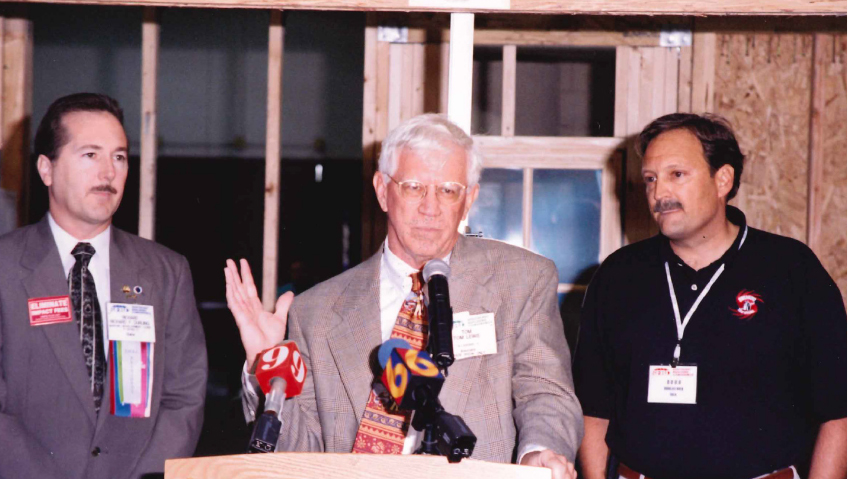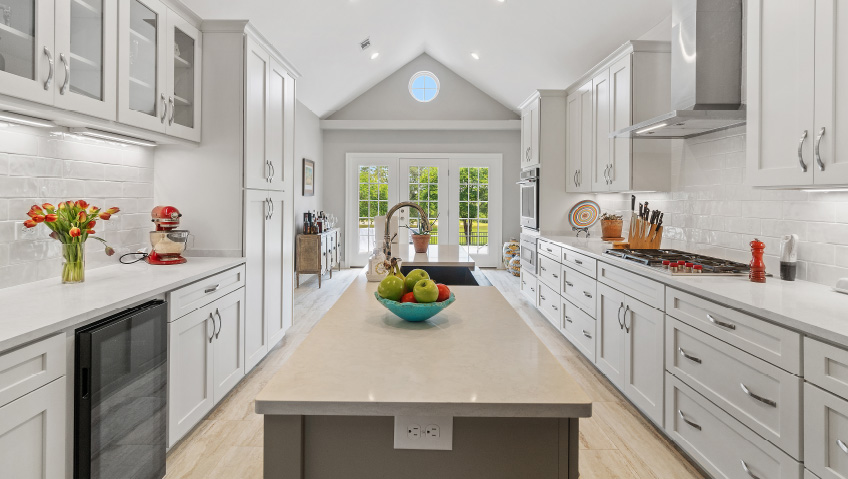From excessive heat and humidity to floodplains, hurricanes, and wildlife, construction challenges in Florida are unlike any other in the United States, and no one understand these challenges better than the Florida Home Builders Association (FHBA).
The FHBA is America’s third-largest builders association. With 23 local chapters and 8,629 members—including over 350 members who have maintained membership for more than 25 years—the FHBA remains one of the most dynamic trade organizations in the U.S. Long affiliated with the National Association of Home Builders (NAHB), the FHBA proudly advocates on behalf of its members and is the leading voice for the state’s construction industry.
Much has changed in the building industry over the years, but the FHBA’s commitment to its members is as strong as it was when the Association was formed in 1947, explains CEO and Chief Lobbyist Rusty Payton, who has been with the Association for a decade. “We are focused on improving the business climate, and we do that a lot through the legislative arena,” he explains. “We really haven’t changed our focus; in fact, when I was hired, I was told my number one job was to enhance political relevancy. That’s been the focus ever since I got here.”
Representing Florida’s homebuilding industry, the FHBA helps create “the best possible economic and regulatory environment for our members to succeed,” states the Association. Along with advocacy, the FHBA remains a valuable source of up-to-the-minute news, information, education on licensing, products, and services, and much more.
The FHBA’s lobbying efforts strive to reduce and eliminate cumbersome regulations and laws that burden the homebuilding industry and drive up the cost of homes. The team recently identified three main priorities for 2025, all state issues. Ryan Benson, who was sworn in as President on October 11 for a one-year term, says the first issue addresses the provision in the impact fees governments are allowed to charge, and there is a cap on increasing those fees, except under extraordinary circumstances. “There is no working definition of ‘extraordinary circumstances’ so local governments—at their discretion—were allowed to use that provision to raise fees as much as they wanted,” comments Benson. “We are looking to put some parameters around that.”
Another issue for the Association is environmental mitigation banks, “a practice in which an environmental enhancement and preservation project is conducted by a public agency or private entity to provide mitigation for unavoidable wetland impacts within a defined region,” according to the Florida Department of Environmental Protection. The FHBA is seeking more such mitigation banks.
And then, there is the issue of hurricanes and how they affect Florida properties. With hurricane season lasting from early June through the end of November, Floridians deal with excessive rain, wind, and flooding each year. The federal government has a 50 percent rule; if owners make changes or improvements to more than 50 percent of their property, they must bring their property up to all codes, including elevation.
“There’s a provision in there where any work you’ve done one to three years before would count against you and that 50 percent,” says Benson. “So in order for people to rebuild from hurricanes without forecasting, ‘Oh, I want to do a remodel, but hopefully my house doesn’t get destroyed by a hurricane in the next two years,’ we want them to be able to not have a lookback period; essentially, the hurricane is the new event. Also, in that, any work being done to make your home more resilient will not count against you for that 50 percent rule.”
Along with these three key priorities, Payton says there will be other issues to address when the Association meets in the fall. “There are dozens of bills we will be reacting to, some supportive and some in opposition,” he says. “Our dance card is not yet complete.”
The FHBA is also paying close attention to federal issues that could affect Florida homebuilding, including HUD loans. Passed during the Great Depression, the U.S. Housing Act of 1937 led to the development of the Department of Housing and Urban Development Act of 1965, which saw the creation of HUD as a Cabinet-level agency. Designed to make owning a home a reality, HUD loans have lower interest rates and requirements, and are connected to other government programs.
HUD passed a rule (effective January 2025) that, to qualify for a HUD loan, the home has to be compliant with the 2021 IECC (International Energy Conservation Code). “The question then is does Florida’s current code—that we redo every three years—comply with that?” asks Payton. “The State of Florida Building Commission says it does; the Department of Energy at the federal level says it does not, they say we fall two to three percent short.”
Challenging the numbers through the Florida Building Commission, FHBA expects to learn soon if it is to win this issue. “If they come back and we are in compliance, Florida is good to go, and we can keep building things,” says Payton, adding there may be a lawsuit from other states that HUD doesn’t have the authority to make that rule.
For homebuilders, working in Florida presents unique challenges, from weather to building codes. The state’s building code, explains Benson, is one of the most elaborate and resilient in existence, far surpasses building codes in the rest of the nation. Created post-Hurricane Andrew in August 1992, Florida’s building code has been continually refined.
However, the federal government has dictated Florida’s floodplains, picked zero as a number, and changed flood maps over the years as more information becomes available. As a result of Hurricane Irma in September 2017, they went to a criterion of +1, so the elevation at which homes need to be, such that they are safe from floods in Florida (post-Hurricane Irma), is now +1, and there is discussion about +2.
There is good and bad to this, says Benson. “The bad, from an insurance standpoint, is every house that has been built up until then will be technically non-conforming, and it becomes very challenging to insure it. The good is, with a +2, even with many catastrophic events, new homes being built will sit further outside that floodplain. So those are some of the unique challenges we have in Florida being a low-lying state… It is more challenging to navigate than most other states.”
Of course, much like the rest of North America, Florida continues to wrestle with the lack of affordable and workforce housing. Fortunately, this remains a key item for the FHBA. People who make within 120 percent of the area’s median income are referred to as ‘workforce,’ while those earning 80 percent or less of that median income are grouped as ‘affordable’ from a unit standpoint.
“Our focus, because of the large migration into Florida, has been on delivering the most units at the most affordable price, and that takes a workforce,” says Benson. “And we also have to get the workforce here, and they have been coming from many other states. But part of that is they need to have an affordable place to live, so our focus has been on delivering more affordable places to live to encourage those from other states to come here and assist.”
Along with being FHBA President, one of Benson’s volunteer roles is serving as Chair of the Florida Housing Finance Corporation, the state’s affordable/workforce housing entity.
Last year, the State of Florida implemented the Live Local Act, considered the most transformative and aggressive affordable housing initiative any single state has taken. Along with funding apartment developments around the state, there is a generous home ownership program for first-time homebuyers and veterans, and creative components, such as developers building apartment complexes being able to get portions of their property taxes waived if they dedicate a portion of the units to affordable rents. There is the corporate tax initiative, where companies—instead of paying state corporate tax—are allowed to apply that money toward developing new affordable units through the corporation as well. “So, there are a lot of interesting components to that that are worthy of mention, as they complement the efforts of the Home Builders Association,” says Benson.
Last session, the FHBA grappled with the CTE Bill (Current Technical Education Bill), which had a provision for 16- and 17-year-olds to work on construction sites. They had to meet certain criteria, including taking OSHA-10 certification, not being up on high roofs, and being supervised by someone experienced and of a certain age. “What we found we were missing were those kids looking for post-high school CTE opportunities. They were finding an introduction into those opportunities before they exited high school, so by the time they left high school and became eligible to come and learn about construction, [those opportunities] were already taken. This opens up the opportunity for those kids to come in and get on a construction site.” This ties in with the goals of the FHBA Foundation, which grants scholarships to younger persons in the trades.
Along with its many advocacy efforts, the FHBA is also behind the Southeast Building Conference (SEBC). With a range of dynamic speakers and over 350 exhibitors, the SEBC is the Southeast’s largest trade show. Continuing to grow, last year’s Conference drew 7,500 registered attendees. A great place for FHBA members to meet people from other states, interact with suppliers, and see all the new technologies, the next SEBC will take place July 24-25, 2025 at the Gaylord Palms Resort & Convention Center, in Kissimmee, Florida.
Continuing to advocate for its many members, the Florida Home Builders Association realizes the importance of being flexible and speedy responding to issues. The reason, states Benson, is the composition and structure of the Florida Legislature, which meets for only 60 days a year. “From a government structure standpoint, the way Florida differentiates is, we are made up of an upper house and the lower house, but they only convene formally 60 days a year, where all legislation needs to take place.” Representatives are only there for two years, with term limits of eight years, and senators getting two, four-year terms. This means the legislature is always very fresh, and everyone is coming with his or her own ideas and changes they want to make.
In an ever-evolving industry, the Florida Home Builders Association remains a steadfast advocate for its members, navigating the complex challenges of Florida’s construction landscape. From tackling state regulations and environmental concerns to addressing the impact of hurricanes and the critical need for affordable housing, the FHBA’s leadership continues to push for meaningful change. Through strategic lobbying, educational initiatives, and its commitment to fostering a strong workforce, the Association ensures that Florida’s homebuilding industry thrives in the face of adversity.






